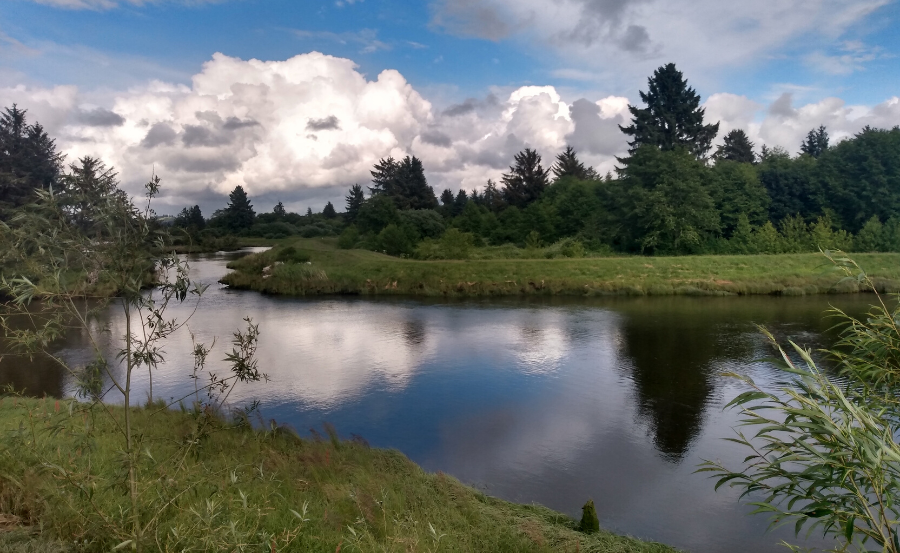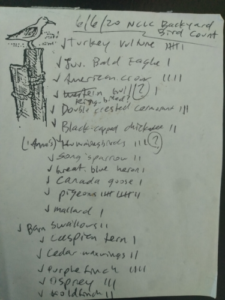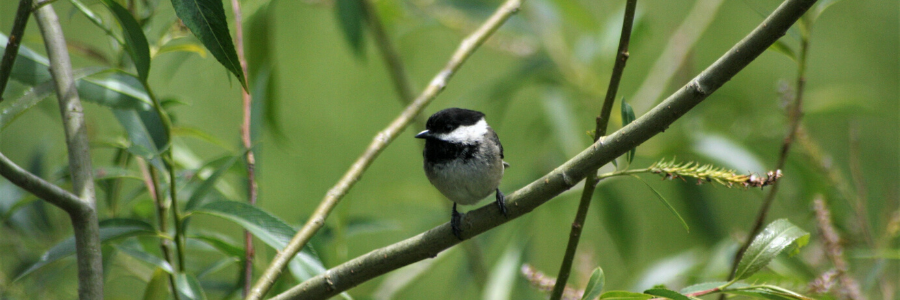
Thirty people from Astoria to Waldport participated in NCLC’s first Great Coastal Backyard Bird Count on June 6, inspired by the need to stay close to home this spring. Among them was NCLC’s Land Steward Eric Owen. Here is his account of the day. Scroll down for a link to the bird count totals.
I am incredibly fortunate and grateful to live where I do, in an apartment perched directly on the bank of the Skipanon River near downtown Warrenton, where an island bisects the river, splitting it into two respective channels. There are big spruce on the island and big alder in the wetlands on the other side of the river. Willow and other native shrubs intersperse along the banks. The diversity of habitats accommodates a nice diversity of birds as well. Winter ducks and summer cormorants, among other waterfowl, frequent the waterway. Shorebirds like pipers and plovers intermittently scuttle about the tidal mudflats at low tide. Songbirds of all kinds, migratory and resident, chirp in the trees on the banks and around my apartment. And birds of prey like osprey, eagles, and harriers (and the occasional red-shouldered or sharp-shinned hawk) patrol the area pursuing their prey.
 What I guess I’m saying is that I don’t usually have to go far to see a variety of birds, and so I’m often content to stay right here at home to do so. Although, every once in a while, I will get the urge to go out and see different species that won’t be found here. I remember learning several years ago about how the birding community was attempting to phase out the use of the phrase “bird-watching” in favor of “birding,” presumably to shift the stereotypical image of retirees languidly lounging around watching the birds go by into a more active approach and definition. Birders are serious. Is that the distinction between birding and birdwatching? Does it really matter? It’s fundamentally the same practice, and I couldn’t really care less how we describe it. I’m just as happy to sit back and see what comes by as I am to go out seeking other species. Call it what you will.
What I guess I’m saying is that I don’t usually have to go far to see a variety of birds, and so I’m often content to stay right here at home to do so. Although, every once in a while, I will get the urge to go out and see different species that won’t be found here. I remember learning several years ago about how the birding community was attempting to phase out the use of the phrase “bird-watching” in favor of “birding,” presumably to shift the stereotypical image of retirees languidly lounging around watching the birds go by into a more active approach and definition. Birders are serious. Is that the distinction between birding and birdwatching? Does it really matter? It’s fundamentally the same practice, and I couldn’t really care less how we describe it. I’m just as happy to sit back and see what comes by as I am to go out seeking other species. Call it what you will.
In any case, when NCLC decided to hold the Coastal Backyard Bird Count in lieu of our first On the Land Walk (due of course to the COVID-19 crisis preventing people from gathering in groups), I was excited. I’d heard about the Great Backyard Bird Count and the Christmas Bird Count and others before, but had never participated in one. I had started a yard bird list (or apartment/back porch list, to be more accurate) three years ago after I first moved into this place. I was bummed when the list mysteriously went missing a year later, and haven’t kept one since. This was a good opportunity to start keeping lists again. (Where, at least, I will have uploaded my observations before the list inevitably gets lost …)

Black-capped chickadee
On Saturday, June 6, I ended up spending only about an hour in total participating in the bird count. I had intended to dedicate more time to it, but life’s other interruptions got in the way, as it so often happens. That’s OK. I found convenient breaks in between rainshowers to sit out on the back porch and just relax and observe. I did not see some regular and interesting birds that I’ve been seeing at other times in recent weeks. The brown-headed cowbirds (not a particularly beautiful bird, but a very interesting one as a brood parasite), spotted the very days before and after, but not on June 6! The various warblers (yellow, orange-crowned, and Wilson’s, all vibrant), that I’d been seeing in the previous weeks. The green heron that has been flying by almost every day just before dusk the last few weeks. I was hoping and expecting to see them, but it didn’t happen on this day. That’s also OK.

Song sparrow
That’s one of the cool things about birding (or bird-watching!), is that regardless of whether you see a species you were hoping for, there are always other fun and interesting birds to see. I’ll spare you from reciting my entire list here, but all told, I recorded 18 species and 51 individual birds among them. Some of those that I most enjoyed were the three osprey that soared gracefully overheard just before dark, the cedar waxwings buzzing by with their sharp colors, the purple finches chittering about in the big redwood in the yard, and the sleek Caspian tern, searching and wind-hovering over the water for fish, my first spotting of one here this year. I think I can say fairly confidently that my least favorite sighting of the day was the ubiquitous flock of rock pigeons.
And I suppose that’s OK as well.
Thirty people identified a total of 77 bird species during the first Great Coastal Backyard Bird Count. Downolad the list of birds identified.
The bird count was part of Get Outdoors Day, a statewide event organized by the Coalition of Oregon Land Trusts. The day is over, but there’s still lots of online content to explore.
It also happened to coincide with the first #BlackBirdersWeek, a time to celebrate and encourage birdwatching—and getting outdoors for any reason—among people of color. An Oregon Public Broadcasting story explored the particular challenges Black conservationists encounter in this state.
Comments